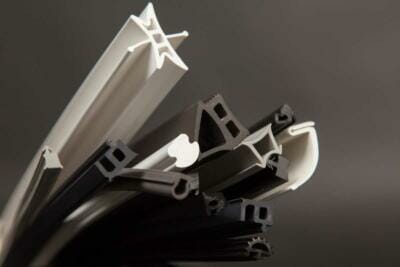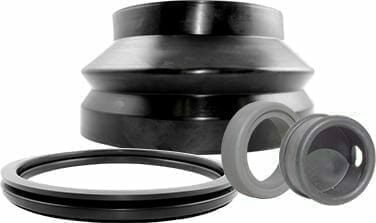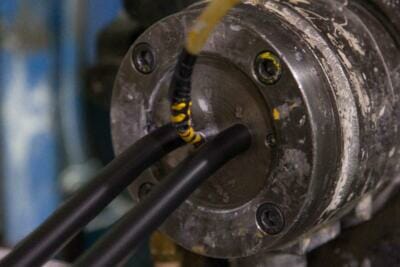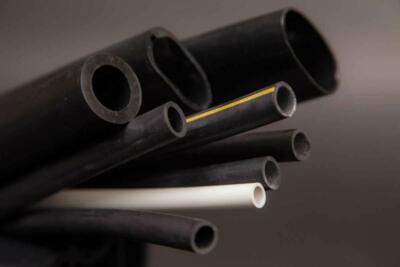How are Rubber Components Made?
 Rubber components are integral to many items we use daily, from home appliances and cars to pencils. These rubber parts provide us with the tools we need to live comfortably and be productive. But have you ever wondered how they are made? While rubber is ubiquitous, most people seldom see it coming off the assembly line.
Rubber components are integral to many items we use daily, from home appliances and cars to pencils. These rubber parts provide us with the tools we need to live comfortably and be productive. But have you ever wondered how they are made? While rubber is ubiquitous, most people seldom see it coming off the assembly line.
The majority of rubber parts are produced through either rubber molding or rubber extrusion. Companies like Qualiform employ advanced technologies to manufacture complex rubber parts for a diverse range of industries. But what exactly do molding and extrusion involve, and how do they differ?
Rubber Molding vs. Rubber Extrusion
Rubber molding is the more common of the two processes, but it ultimately depends on what industry you are in. This process can create three-dimensional shapes, making it ideal for complex parts in the assembly of various mechanical systems.
Rubber extrusion, on the other hand, produces two-dimensional parts with continuous lengths, which are intended to be cut to fit the needs of the given application. Extrusion is a fairly straightforward process, making it much more efficient. However, rubber molding is not so simple. There are many ways to go about rubber molding.
Rubber Molding Processes
Rubber Injection Molding
 Injection molding tends to be the go-to process for creating components, especially for rubber to metal bonding applications. If you are looking to produce high volumes of rubber parts with tight tolerances and over-molding, injection molding is what you need.
Injection molding tends to be the go-to process for creating components, especially for rubber to metal bonding applications. If you are looking to produce high volumes of rubber parts with tight tolerances and over-molding, injection molding is what you need.
The rubber injection molding process offers superior speed and precision, so you can create high-quality parts with a much quicker turnaround. This makes it ideal for rubber compounds with quick cure times. Some other advantages include efficiency through automation and reduced waste production.
Rubber Compression Molding
Compression molding is usually the method of choice for producing low to medium-volume runs of rubber components. It is most often used to create large rubber products with complex shapes and dimensional requirements. Some common compression molded products include environmental seals, o-rings, and gaskets.
Rubber Transfer Molding
Transfer molding is a process used to produce solid rubber parts as well as components that need to be bonded to metal components or other non-rubber materials. Some examples of the parts transfer molding creates include shock absorbers and vibration isolators.
Rubber to Metal Bonding
This is a secondary rubber molding process intended for connecting rubber to metal components. Rubber to metal bonding is the ideal choice for high-impact applications, as the metal’s hardness and the rubber’s flexibility work in tandem to offer superior resilience. Transfer molding is the most common choice for molding the metal prior to bonding, but injection molding is also viable.
The Rubber Extrusion Process
 Extrusion is not a process that is exclusive to rubber materials. It can also be used with metals, concrete, polymers, and much more. Regardless of the material, extrusion creates parts by pushing the material through a die shaped to the proper cross-section. This process can produce parts with highly complex cross-sections, allowing for more versatility in the design.
Extrusion is not a process that is exclusive to rubber materials. It can also be used with metals, concrete, polymers, and much more. Regardless of the material, extrusion creates parts by pushing the material through a die shaped to the proper cross-section. This process can produce parts with highly complex cross-sections, allowing for more versatility in the design.
Rubber extrusion is particularly beneficial because it can create a full range of shapes and sizes for rubber components. There are several applications for rubber extrusions that are not only for the industrial sector but also things we use in our daily lives.
Industrial applications include rollers, sheets, and rods for the absorption of loud noises and extreme vibrations. Everyday applications include window glazing for windows, car doors, and many other sealing applications as well as many other components in home appliances, vehicles, bicycles, and even space shuttles! Rubber extrusions are exceptionally versatile, but to ensure they perform properly, you need to choose the right rubber compound.
Choosing the Ideal Materials for the Job
 Picking out the rubber compound you want for your project can be difficult, especially if you just don’t know that much about rubber. There is also the worry of picking the wrong one and wasting money on parts that won’t work! So, where do you even start?
Picking out the rubber compound you want for your project can be difficult, especially if you just don’t know that much about rubber. There is also the worry of picking the wrong one and wasting money on parts that won’t work! So, where do you even start?
Let’s say you go with Thermoplastic Elastomers (TPE). Not a bad choice, necessarily, but TPEs have several types with different properties, so how will you know you are making the right choice?
Qualiform Rubber Molding can help you avoid all these confusing issues with our wide selection of rubber compounds and expert staff. We can take all the environmental factors of your applications and the dimensional requirements of your products and use the information to find the perfect compound for your project!
Why Choose Qualiform Rubber Molding?
If you are looking for a rubber molding or rubber extrusion company, you can depend on Qualiform Rubber Molding. We are experts in injection molding, compression molding, transfer molding, rubber to metal bonding, and extrusion, so we can develop the parts you need for virtually any application. Qualiform is also certified to ISO 9001:2015, meaning we have continuously proven our ability to create high-quality parts for a wide range of industries from agriculture to aerospace.
We run a state-of-the-art manufacturing facility that operates on a 3-shift/24-hour schedule, so we can create the parts you need, when you need them, at a price you can afford. Not sure what you are looking for? Contact us today, and our team of rubber extrusion experts will be happy to help you get started on your project!

